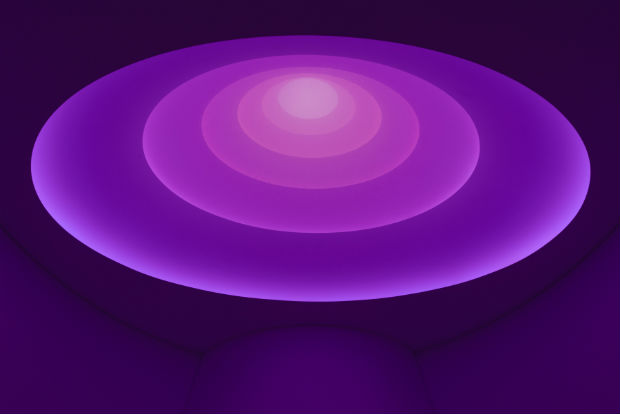With “Aten Reign,” James Turrell has transformed the Guggenheim’s spiraling rotunda into the rings of Saturn. This grandiose installation, nearly eight years in the making, opens to the public today. Similar to many of the artist’s sky spaces, “Aten Reign” reveals a subtle change in the room’s lighting, through color and texture, from day to night. It’s quietly brilliant, just to sit, watch, and wait for light to morph from solid to thin, and color to naught.
The Guggenheim has high hopes for Turrell’s installation, which is a simple combination of fabric, LED lights, and skylight. “It’s an extraordinary experience people will remember forever,” Guggenheim Curator Carmen Giménez optimistically mentioned during the press preview, before adding, “Light is Turrell’s raison d’être.”
Certainly, Turrell would not argue with that statement. When it came time for Turrell to speak during the preview, he focused on light’s cosmic and sensuous qualities. “We were made for the light of the cave,” Turrell stated, when indicating that twilight is the preferred moment for viewing “Aten Reign”. “Aten” it should be noted, is an Egyptian term referring to the deity of the “sun”.
In scale, “Aten Reign” rivals only Turrell’s “Roden Crater Project” (1979 – ongoing), his yet-to-be-completed sky space inside an extinct volcanic cone near Flagstaff, Arizona. Physically, the two installations have much in common: both share a sun-like disk separating the interior viewing “cave” from the cosmos. For Turrell, the difference lies in the type of light passing through; at Roden Crater, the passing light will come from the ends of the solar system, in comparison to the thin, “Beaujolais” light in “Aten Reign”.
During my midday viewing, the light seemed noticably thin. While sitting in the Guggenheim rotunda’s built-in benches, I stared up at the ceiling for nearly five minutes before noticing any change. Once the light reached its “sweet spot” (Turrell’s term), the shift was barely perceptible, from tones of gray to lavender. It’s a small payoff for such a large installation and I wonder if it’s enough. Staring at anything for long enough will likely reveal simple facts about the universe.
Regardless, the rewards of Turrell’s installation lie not in grandeur or pageantry, but a principle shared by art and spirituality, that of letting us see and feel the invisible. At the very least, the exhibition forces us to slow down, and take a minute out from our fast-paced lives. That might be enough, but for some, it’s harder to figure out what to do with our newfound patience once we leave the Guggenheim.



Comments on this entry are closed.